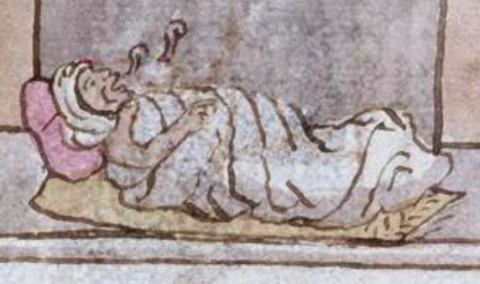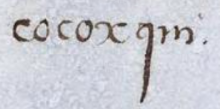cocoxqui (Osu6v)
This might be called a simplex glyph for the term cocoxqui (sick person), or else we could include it here as an example of iconography for comparing with glyphs about illness. It comes from the Codex Osuna, folio 6 verso (or Image 15). The scene is a person lying horizontally, body and head wrapped in white (cotton?) cloth, and with the head resting on a red pillow. The person’s right arm is outside the covering. Two speech scrolls emerge from the person’s mouth, suggestive of moans relating to the discomfort of the illness. The cloth has many folds, giving it a three-dimensionality. Underneath the person is a yellow woven mat (petlatl), which was often the object upon which people slept (and some still do).
Stephanie Wood
The building, shown in a frontal view, whic is surrounding this person who is suffering an illness, is glossed in Spanish, “Ospital de los Yndios” (Hospital for the Indians). The construction of hospitals got started in the 1520s, evidence of how early epidemic diseases were becoming a problem (within three years of the Spanish seizure of power of the capital). On the same page with this hospital scene appears the count of 350 half-fanega loads of lime (tenextli) that was demanded from the Indigenous people in “tribute” (a tax in kind) for the construction of a hospital (and this was in the 1560s). Smallpox, measles, and typhus were some of the diseases that decimated the Indigenous population in the sixteenth century (and recurred periodically after that).
John Montgomery has drawn a couple of examples from Aztec manuscripts (unnamed) where epidemic disease seems to be referenced.
Stephanie Wood
1551–1565
Jeff Haskett-Wood

cocoxqui, an ill person, https://nahuatl.wired-humanities.org/content/cocoxqui
una persona enferma
Stephanie Wood
Library of Congress Online Catalog and the World Digital Library, Osuna Codex, or Painting of the Governor, Mayors, and Rulers of Mexico (Pintura del Gobernador, Alcaldes y Regidores de México), https://www.loc.gov/resource/gdcwdl.wdl_07324/. The original is located in the Biblioteca Nacional de España.
"The Library of Congress is unaware of any copyright or other restrictions in the World Digital Library Collection. Absent any such restrictions, these materials are free to use and reuse." But please cite the Biblioteca Nacional de España and this Visual Lexicon of Aztec Hieroglyphs if you use any of these images here or refer to the content on this page, providing the URL.












